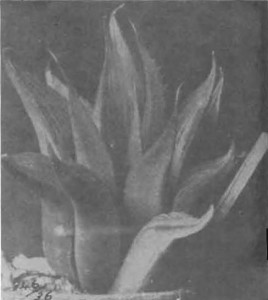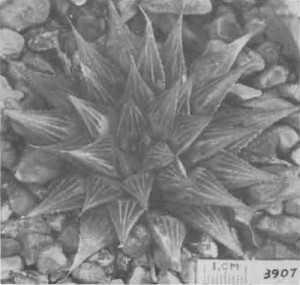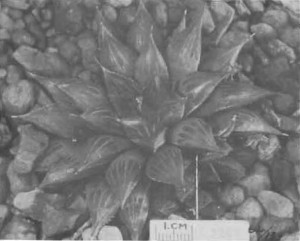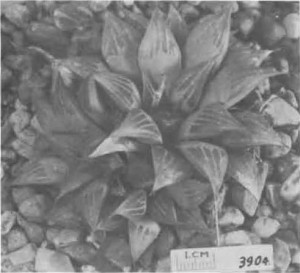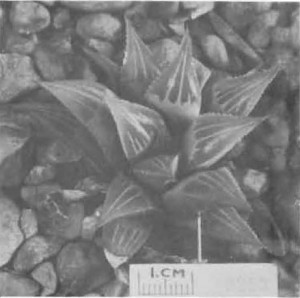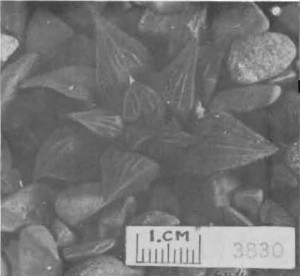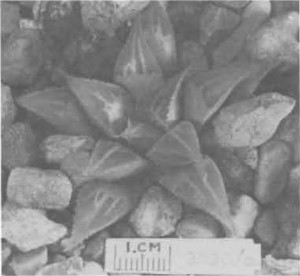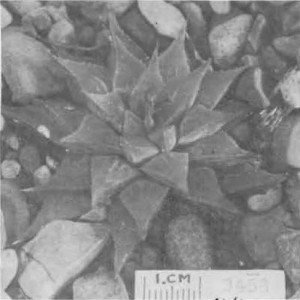Previously published Cact S.Jl 52.1 1980
M. B. Bayer, Karoo Botanic Garden, National Botanic Gardens of South Africa
Haworthia nitidula was described by von Poellnitz in Desert Plant Life (11:192, 1939) from plants collected by Major H. Venter. Venter was very generous with his localities and like most of his others, this no. 15 was also simply cited… “in the environs of Worcester, Swellendam, Caledon and Bredasdorp”. This is an ideal example for demonstrating the problems of identification of haworthias and especially in the section Retusae Haworth. J.R.Brown illustrated H. nitidula in the Cactus and Succulent Journal (18:89, 1946) but apart from this and the original illustration accompanying the description, the plant has not figured in the succulent literature. In G.G.Smith’s records, the species and nine varieties are distinguished. The interesting thing is that these varieties are drawn from three geographically separated species. The object of this article is to present Smith’s photographs and notes of his “varieties” and discuss their actual position as they relate to distribution.
Fig.1 is the original illustration of von Poellnitz. Fig. 2 is a photograph in the H.C.Fourcade record of Major F. R. Long’s collection comparable with J. R. Brown’s illustration. Fourcade was actually a forester with a more than passing interest in botany. He recognized the belated significance of Long’s collection and attempted to make a photographic record for posterity. Unfortunately this was undertaken several years after most of the new species of von Poellnitz had been described so there is some uncertainty that the plants photographed were actually what they were purported to be. In the case of fig.1 the photograph is actually said to be of type material from Venter’s collection no.15. It can be said to agree favorably with the figure in Desert Plant Life. Fig.3 is of a plant GGS 3907 from Venter as no.15 and is recorded from Greyton. This locality must be taken to be the best clue to actual origin, and the descriotion and illustration agree with the form of H. mirabilis Haw. which is common in the area as well as elsewhere in the Caledon, Napier, Bredasdorp, Riviersonderend, Stormsvlei, And Genadendal districts. Figs 4-8 are photographs of various plants from the Bredasdorp area and these are all H. mirabilis (see Bayer in Excelsa 7:37, 1977).
Strangely, von Poellnitz did not make a connection with any of his H. triebneriana varieties, although he does compare H. nitidula with H. rossouwii which is more than probably also a synonym of H. mirabilis. Figs.9-10 are of plants from the Heidelberg (Cape) area and the field association is clearly with H. turgida Haw. as recognized by the writer in his Haworthia Handbook (1976). There will inevitably be confusion if C.L.Scott’s…”Revision of the Section Retusae” (Aloe, 11:26, 1973) is taken seriously, because Scott upholds H. nitidula, citing an unnumbered Venter collection in the Bolus herbarium collected from 3km north of Worcester as the neotype. This locality is in the Karoo Botanic Garden where the nearest comparable species is H. herbacea (Mill.) Stearn (for which Scott prefers the name H. arachnoidea (L.) Duv. in Cact. & Succ. Jl (U.S.) 49:205, 1977). The illustration accompanying Scott’s new circumscription of H. nitidula is actually the photograph of the type of H. longibracteata Smith. The writer’s view of H. longebracteata is that it is on the intergrade between H. turgida as illustrated in figs. 9 and 10 and is conveniently lumped with H. retusa (L.) Duv.
Figs.11 and 12 are Smith’s photographs of plants collected by J. Dekenah and M. Otzen north of the Langeberg mountains in the Riversdale district. Smith put these with H. nitidula. (Actually the position is that this locality just north of Muiskraal is exactly the interface of emelyae and its variety multifolia. Although emelyae is known a few kilometers to the east and the var multifolia barely a kilometer to the west of these records, it has not been recorded north of Muiskraal again). The field position here is that H. magnifica var. major (Smith) Bayer (now H. emelyae var major) occurs in this area in Table Mountain Sandstone and there is an intergradation between this species and H. emelyae V. Poelln. occurring in grossly different geological formations from west of Ladismith to east of Oudtshoorn.
Thus one sees that Smith’s concept of H. nitidula was derived from three different elements and Scott’s from two. The figures together show how difficult it is to portray species in this group even with many photographs. How ever many pictures are used one still gets but a small taste of the complexity of the situation in the field without even considering the problems which arise from changes in the plants in cultivation. There is no doubt that lumping all the ‘retuse’ haworthias into one species to also include some ‘non-retuse’ species such as H. herbacea (Mill.) Stearn and H. serrata Bayer, needs to be seriously considered. Apart from H. parksiana v Poelln. there are obvious problems of integradation between all of the species upheld by the writer in Haworthia Handbook, and many populations lie in the balance between one or another. The problem also does not end there because there are a few populations which link the geographical ‘retuse’ with the geographical ‘non-retuse’ species. This particular article shows how confusion has arisen between plants of H. mirabilis on one hand and H. retusa and H. turgida on the other, and yet these present no real problems in the field. The same cannot be said for H. turgida and H. retusa where the distinction is extremely tenuous in the field and worse in collections of odd specimens. Geographical distribution is the primary key to the whole group. The collector has no basis for pontification about names and has no alternative but to accept an undesirable state of affairs which nature will probably remedy in her own time.
The end-piece to the story is that Smith’s pictorial concept of N. nitidula could ironically serve as a very sound base from which all the south-western Cape species in the subgenus Haworthia Bayer ex Uitewaal can imaginatively be derived.

